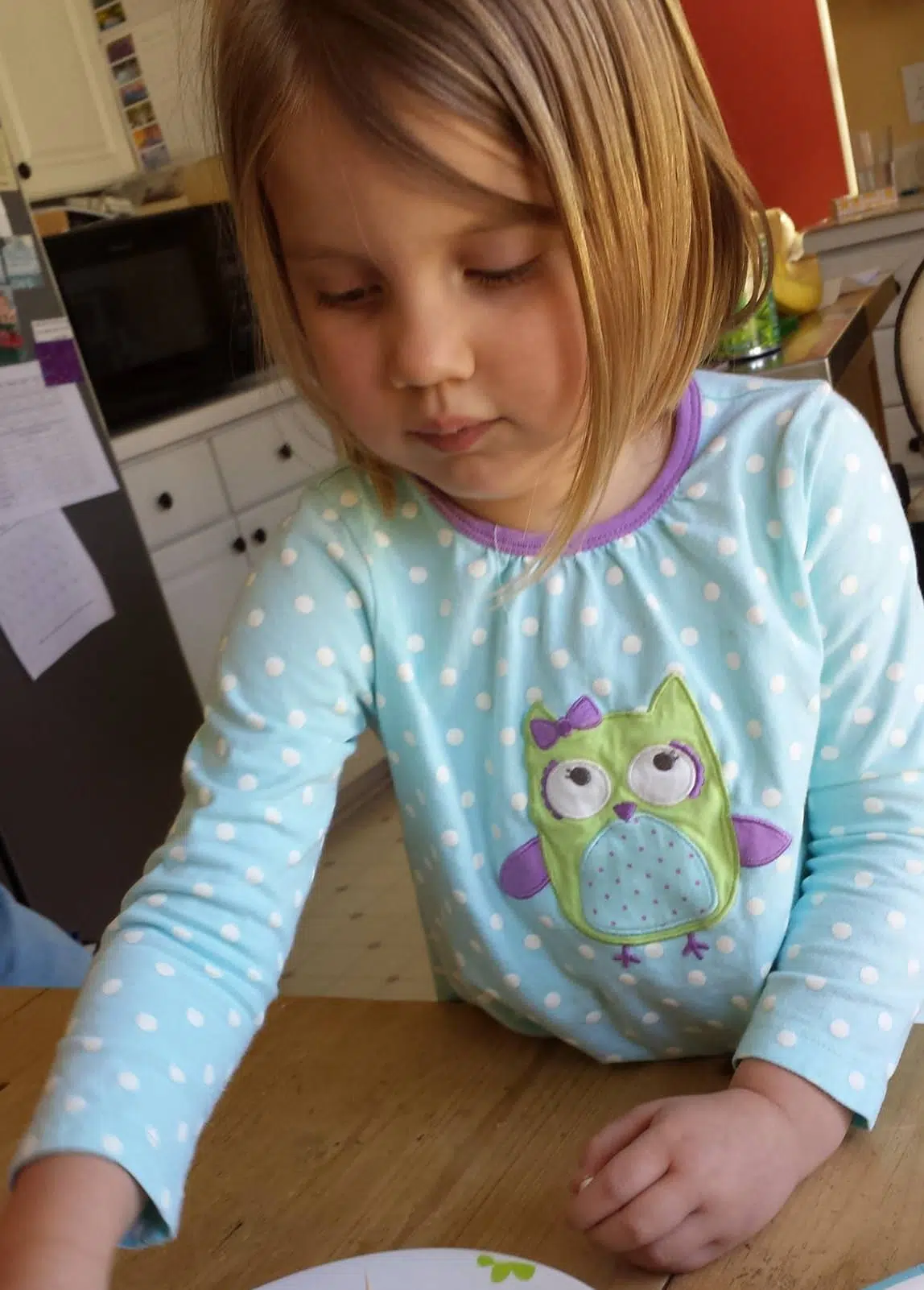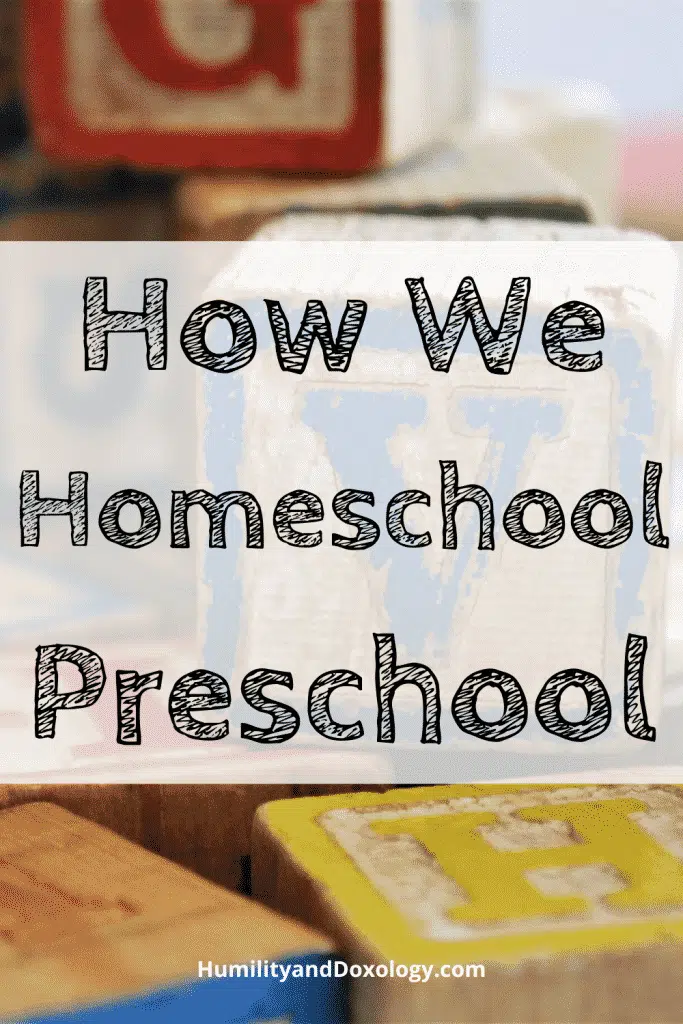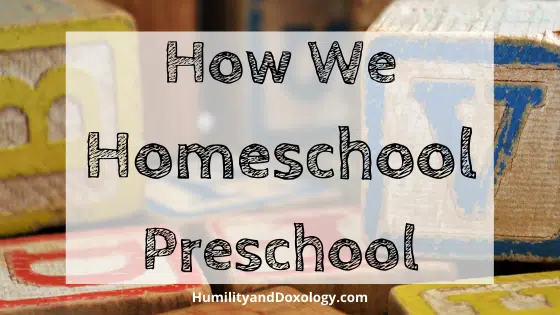“How do we homeschool preschool?” One of the most common questions I see in the online homeschooling space comes from excited Mamas eager to find the best curriculum for homeschooling their preschoolers. I remember well that eager feeling as a new mom. It’s so thrilling to see all the books and possibilities out there!
What if your best tool for homeschooling preschool is changing your perspective, not buying a curriculum?
But what if the best homeschool preschool curriculum doesn’t come in a box or a textbook? What if you don’t have to plan dozens of projects? What if there is a natural, peaceful, and productive way to pursue preschool at home?
My 5th child is now preschool age. I’ve done preschool at home with all 5 of my children, who have exhibited a range of academic giftedness, emotional intelligence, motivation, and personality. But, with a few modifications, I have used the same approach to preschool with all of them…and I have never bought a pre-made preschool curriculum!
Let’s start by looking at the Big Picture Goals for the preschool years, then dive into the details of learning math, reading, and more!

{This post contains affiliate links. Please see disclaimer.}
How We Homeschool Preschool: primary goals for the preschool years
It may help to ask what our goals are for the preschool years. Set aside all the Chicken-Little drama and early-academic pressure you may have heard. When your precious little one transitions to the more “official” school years, what do you think will have prepared them best?
When I ask myself that question, here are a few of the things that come to mind. Your goals may be a little different, and I encourage you to prayerfully think through them and discuss them with your spouse.
Relationship
- Fostering a nurturing, loving bond with our young children
- Encouraging growth in empathy and emotional intelligence as they relate to their family and friends
- Sharing stories
- Building memories
Faith
- Praying with and for my children daily
- Giving them a thorough introduction to the stories of the Bible, and the overarching story of the Gospel
- Facilitating their memorizing of Scripture through Bible songs and daily recitation with the family
- Catechizing them
- Faithfully taking them to worship each week and encouraging their participation as much as is reasonable for their maturity
- Modeling repentance to them when I sin, and helping them learn to ask for forgiveness when they sin against others
- Pointing them to Jesus in every way I can
Self-Control
- Teaching my children boundaries, and helping them learn to submit to authority
- Assisting them as they practice self-control and learn self-discipline
- Giving them opportunities to work and serve with the family through simple chores

Learning
- Encouraging curiosity and imagination
- Developing a love of learning
- Facilitating natural, organic acquisition of knowledge
- Helping my children see the glory of God in all areas of study
- Giving my children the tools they will use to continue building their own education as the years progress
What other goals do you have for the homeschool preschool years?
That was certainly not an exhaustive or authoritative list. What are some other goals you might have for the preschool years? What are ways we may be allowing the fears and priorities of outside forces to shape our approach to early childhood education? How might we examine our family’s culture and goals instead? What kind of human do we want to be raising, ultimately, and how do we begin nurturing that even in these young years?

How We Homeschool Preschool: Plans for the Most Important Subjects
That’s all well and good, you may be saying, but I thought you were going to lay out a Homeschool Preschool Plan for us!
Indeed! But before you move on to the areas more traditionally associated with academics, it is useful to set those big picture goals above. As you read through the ideas, tools, and suggestions that follow, remember that all of them flow from my overarching goals of deepening relationship with my preschoolers, showing them how our faith relates to every facet of our life, nurturing the seeds of self-control, and developing a life-long love of learning.
Foster a love of books and language
There’s no need to push early reading skills in a formal way. The most important thing you can do with your preschooler is to expose them to lots of beautiful language.
Conversation
Don’t underestimate the power of your daily interaction and conversation with your little ones, even when you think the 3-year-old can’t really understand the vocabulary you’re using. Describe and narrate the world around both of you.
For example, imagine you’re in the grocery store choosing vegetables. You might say something like, “What a vibrant shade of green! These peppers look so crisp and delicious. The pepper has a squishy portion, so we will choose a different pepper. Let’s put 3 peppers in the bag: 1, 2, 3!” You’ve now combined vivid descriptive words, comparison/contrast, and counting all in one simple interchange, no curriculum required.
It’s also a delight to transcribe the stories your little ones imaginatively weave for you. I have an early memory of dictating the adventures of a penny to my mom, who carefully wrote my words on pages for me to illustrate. This is laying a lovely foundation for future writing and communication skills, and shows that you respect their thoughts and imagination.
Read-Aloud
Meaningful conversation is one of the easiest ways to foster a child’s vocabulary, phraseology, and ability to communicate with words. But beyond this purposeful verbal interaction, we want to expose our children to the beauty of the written word.
No need to break out the alphabet or sight word flashcards! Spend the same amount of time reading beautiful stories aloud with your preschooler snuggled on your lap, and I’m pretty sure both of you will be less bored and more excited about what you’re doing.
Some favorites here in our family are books by Robert McCloskey, Virginia Lee Burton, Donald Crews, Sandra Boynton, Beatrix Potter, Eric Carle, Helen Oxenbury, and Dr. Seuss. In fact, I think if I had my copy of Make Way for McCloskey (an anthology of his work), I could almost live on that alone. I never get tired of reading those stories aloud to my littles! (You can find my preschool picture book round up here!)


Sharing stories with our children is also one of the best ways to develop our relationship with them. If you want to be reminded of the impact this simple practice can have in your family read The Read Aloud Family by Sarah Mackenzie or The Read Aloud Handbook by Jim Trelease.




Letter Recognition and Pre-Reading Skills
But what about letter recognition? There is currently so much pressure to read early that we see formal reading instruction happening earlier and earlier! The range for “normal” is so varied, however. Here in my own family, for example, I’ve had children begin reading independently anywhere from age 3 to almost 7!

The most effective means to teaching pre-reading skills that I have found is to incorporate letter recognition and discussion naturally into our daily life. Dr. Seuss’s ABC and Chicka Chicka Boom Boom, for example, are silly and fun stories that naturally bring in letter names and sounds. Sounds Like Fun is a calming collection of songs that gently educate through music.
Ordinary life, however, is my favorite means of homeschooling preschool. As we go on walks or errands, I might point out some of the letters we see: “Oh, we’re at the corner! See the big red sign? Look at those large letters. I see an S, T, O, P…sssss….tttttt….oooo….pppp….it must say STOP!”

I have always considered that if a small child can learn that a cow says “moo” and a dog says “woof,” they may also be able to learn that a B says, well, “b”! Most preschool children likely won’t be able to visually identify the letter and its sound, but they may be able to connect the name of the letter with its sound.
I encourage you to discuss letter sounds with your children in the same delightful way you teach them to recreate and recognize animal sounds. You’re not showing them flashcards to teach them that a cat meows. You see your neighbor’s cat in the window and you say, “See the kitty? What do cats say? They say, “meow”!” In the same way, imagine you’re leaving a store and there is a sign saying “EXIT.” You might point out the short e sound by saying, “Look! E-X-I-T. E-e-e-exit!”
Sometimes I make up silly stories. For example, did you know that S and H are rather rowdy friends? Whenever they get together they are so very loud that their parents have to tell them “SHHHHH!!!!”
You’re likely (dare I say, hopefully?) not drilling your 3-year-old with color flashcards. Rather, you point to the tomato you’re cutting up for the salad and mention that it is red, you ask them if they’d like the red or blue cup, and you hand them a red crayon when they color the fire engine. In a similar way, you do not have to drill letters/diphthongs/etc. When homeschooling your preschooler, you can draw attention to letters and sounds as they occur naturally in your day.
If you begin to think purposefully, you’ll be amazed how many letters you can gently point out during your ordinary life. This is not meant to turn everything into a lesson; the whole point is that these aren’t lessons! By weaving letter names and sounds naturally into your daily life, you’re encouraging your preschooler to view words and reading as delightful, not something for “school.”
(I also like this idea for incorporating alphabet sensory bins. Have you ever tried this at home?)
Encourage improvement of motor skills, primarily through free play
Gross motor skills include things like running, climbing, hanging, sliding, crawling, jumping, and kicking. Make sure your children have access to places to explore and climb and run and kick balls and throw pinecones. Don’t direct every moment of their play; allow them to tumble and fall and explore and plan and imagine on their own as much as possible. They’re actually making neural connections as they play, even though it doesn’t look like “academics.” Even if our yard isn’t conducive to this level of activity, most of us don’t have to drive very far to find at least a small green space, soccer field, or playground.
To build your preschooler’s fine motor skills (important building blocks for things like holding a pencil), stick to fun activities like playdough, finger painting, sidewalk chalk, digging in sand, stringing beads, stacking blocks, kid scissors, stickers, painting with water, and playing in the mud.




Lay a stress-free math foundation
Math is simply another form of language. It uses numbers to express truths about the world we see around us. A positive approach to mathematical concepts in early childhood will lay a solid foundation for more abstract thinking later on.
We are constantly counting, adding, subtracting, comparing, analyzing, and more throughout the day. Often, for adults, it happens without conscious thought.
Once again, a perspective change is all I’m suggesting. Consider all the ways you could express your daily activities with your preschooler in mathematical form. Here are a few practical examples.
Counting all the things
Cardinal Numbers (1, 2, 3, 4…)
- Climbing up and down stairs
- Setting the table and counting utensils
- Putting away books, toys, or stuffed animals
Ordinal Numbers (1st, 2nd, 3rd…)
- Play cars/trains and discuss which one is 1st, 2nd, 3rd, last, etc
- Waiting in the grocery checkout line: “That lady is first, then that gentleman is 2nd, then we are 3rd.”
- “First we will go to the library, next to the gas station, and last to the grocery store.”
Other Counting Skills
- Anytime you would normally count by ones? Try counting by 2s or 5s or 10s! Walking down the steps? “2, 4, 6, 8, 10, 12, 14 stairs!”
- Try counting backwards whenever possible. About to shut off the bathtub faucet? “Let’s count down; on “blast-off” we’ll turn off the water!”
Mathematical Operations
Inequalities
Any parent knows children have an uncanny instinct for when things are uneven. Susie got more cookies that I did, that cup has more juice than mine, and Joey’s slice of pizza is bigger. As you go through your day, find more impersonal and non-tantrum-producing opportunities to point out things that are bigger/smaller, greater-than/less-than, heavier/lighter, etc.
I love to tell the story of Greater-Than-Gator who always eats the bigger pile. You can even introduce the inequality symbols, too…just add teeth to turn the symbols into an alligator, or use your hand as a puppet-mouth to eat whatever is bigger. Greater Than Gator sometimes has even been drawn with sidewalk chalk at our house while we’re collecting piles of rocks outside on the driveway. (I originally learned the Greater-Than-Gator story as a child from the Making Math Meaningful curriculum.)
Addition/Subtraction
While setting the table: “There are 5 people in our family, but we only have 2 napkins on the table. How many more do we need? Can you bring me 3 more napkins?”
While serving chicken nuggets: “There were 8 nuggets in the box, and it looks like you’ve already eaten 4. There are still 4 left in your box!”
While building with blocks: “We’ve stacked up 5 blocks already! Do you think we can add 5 more to the tower so it is 10 blocks tall?”
While choosing bedtime books: “I said I’d read 2 stories, but you brought me 4 books. Can you please choose 2 to put back on the shelf?”
While on a walk: “I see 2 birds on that branch, 1 bird on the ground, and another bird on the fence. Wow, we can see 4 birds in that 1 yard!”
Putting on shoes: “Look, you have 2 shoes. Mommy has 2 shoes. Daddy has 2 shoes. We have 3 groups of 2 shoes: 2, 4, 6…that’s 6 shoes.”
Adjust your perspective

The ideas listed above are not meant to be exhaustive. I haven’t even discussed the pleasures of music/rhythm experimentation, library story time, nature exploration, poetry memory, arts and crafts, or Scripture memory. Embrace your own personality and the culture of your family, and bring your precious preschooler into the things you love. Your enthusiasm will be contagious!
None of the ideas I’ve suggested, however, require you to set aside “school” time. None of these activities require you to purchase extensive, formal, preschool curriculum.
I want to encourage you to resist the pressure to add in more things to your day. Instead, shift your perspective and your mindset. You’ll be amazed how many hidden (and not so hidden) ways there are to organically and gently encourage growth in body, mind, and soul throughout your homeschooled preschooler’s day.
Questions? Thoughts? I’d love to hear your comments below! Or you can join the conversation on Facebook and Instagram.
Loving this in theory, but really want an open-and-go preschool curriculum option? I have a whole preschool curriculum comparison guide just for you!
You may also enjoy:
- Everything You Need To Homeschool Preschool: A Parent’s Guide
- Preschool Homeschool Curriculum Comparison Guide
- Preschool Picture Book Round-up
- Messy Mangers
- Truth, Goodness, and Beauty in the Homeschool Preschool
- Homeschooling with Babies and Toddlers (with Stephanie Sims)

{Wooden Block Photo by Susan Holt Simpson on Unsplash}








Pingback: Preschool Picture Book Round-up – Humility and Doxology
Pingback: Day in the Life 2019 (with a 13, 11, 8, 6, and 3 year old) – Humility and Doxology
I love all the wonderful activities you do with your preschool kids!
This age is so much fun! I can’t believe it’s my last year with a preschooler.😥
I love this age so much and blessed with my last preschooler too. I was going to rush him into figuring out letter and number recognition last year because they teach all this stuff so early now in public school. I felt like I was failing. But then I sat down and had a heart to heart with myself. He needs to be a kid first and it will come to him through the resources you mentioned (reading, songs, play). You have some wonderful ideas here. This year will start focusing on those number and letters but I want him to enjoy being a kid for as long as possible.
Yes! Those early childhood years of exploration are so important.
I love your perspective, Amy. Play, relationship, faith, self-control, are the focus of our younger years here as well. Letters, numbers, and more ‘academic’ activities are certainly in the daily mix as well, but they don’t consume the bulk of our days. The preschool years are some of my favorites!
Just going through the day-to-day motions with our preschoolers provides ample opportunity to teach and guide. You highlighted that so beautifully in your post!
The Read-Aloud Handbook was a life-changing read for me many years ago, and I’m thankful I stumbled upon it quite by accident at the local homeschool store. I buy it for every baby gift now, as I wish I’d read it much earlier in my mothering life.
xo, Lauren
Oh that is wonderful, Lauren! I love that you give The Read-Aloud Handbook as a baby gift. Recently I’ve been giving Give Your Child the World as a baby gift, especially for mamas who already had a baby previously. 🙂 Nothing better for babies (and their families) than a well-stocked library basket and bookshelf. 🙂
I will really miss the preschool years as I head into my first year with all children 5 years old and above. It’s very bittersweet!